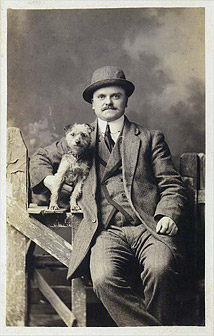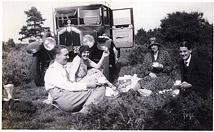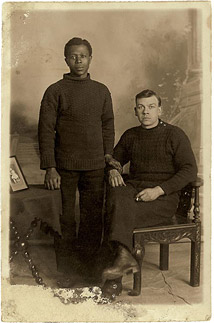We are the People: The Charm of the Ordinary by Kevin Jackson
This essay originally appeared in arts section of The Independent, 22 March 2004, with the title The Charm of the Ordinary; We Are The People documents life in the early 20th Century.
"Wonderful", "deeply moving", "excellent", "wonderful", "brilliant", "enthralling", "wonderful", "hugely enjoyable" and, above all, "wonderful": the National Portrait Gallery's new exhibition has been greeted with the kind of review that most artists can only dream about in their opium reveries or lager trances - a near-unanimous torrent of superlatives and raves. In this case, however, the words of full-blooded praise have been written not by the hard corps of professional photography critics but by hundreds of members of the general public: apart from "wonderful", the most common exclamation is: "Thank you, thank you, thank you!"
Not since the Mass-Observation retrospective of the early Nineties has there been a major photographic show in which the comments in the visitors' book have been as significant a component of the gallery experience as they are for the NPG's We Are the People. The images on display can indeed be very moving; but some of the scribbled responses are equally so, especially when they are written by those in their eighties and nineties. If you can pay a visit, please remember to check out the comments. And maybe add some of your own.
We Are the People is a classically simple idea, made possible by the assiduousness of a single artist - the distinguished painter Tom Phillips, who for many years has been collecting the sort of humble black-and-white photographic postcards from the early part of the 20th century that generally wind up in junkshops or car-boot sales. Initially, Phillips says, his intention was simply to build an archive of faces and postures that might prove useful in his art, but, as it grew into the hundreds and beyond, the collection began to take on a fascination of its own. Roughly 1,000 of the images have now been put on display by the NPG, arranged in subject- based categories such as "Soldiers", "Shops", "Offices", "Music", "Dance" and "Readers".
As Phillips puts it: "These photo postcards are historic in the sense that this was the first time people stepped into the light and were seen as individuals rather than the unpictured masses of previous centuries. I wanted to make an alternative National Portrait Gallery collection featuring the rest of the nation - those who did the work, bore the children, fought the wars; the previously unknown and unsung."
Stirring words, especially for anyone (that is, most of us) whose forebears are and will remain utterly faceless and voiceless: the footsoldiers and the nurses, not the generals and queens. Phillips's project is an appropriate democratic extension of the NPG's original brief, which was to inspire the British to perpetual self-improvement by showing the likenesses of the great and the good. It also - as quite a few of the visitors have shrewdly pointed out - makes a useful balance to all those portraits of the excessively glamorous on display just down the hall in the Cecil Beaton exhibition, as well as, more generally, to the cretinous 21st-century cult of "celebrity" snaps.
Visitors are experiencing the pleasant shock of recognition, the unexpected warmth of closeness: it might have been called Family Portrait. As one visitor wrote, you go around the show half-expecting to see Auntie Dora or Uncle Ray in their seaside finery.
The one thing to which Phillips's resonant mission statement does not quite do justice is the humour and eccentricity of the show. Yes, our forebears did the dirty work and fought the bloody wars; but they also liked to sit in imaginary cars and biplanes, perform gymnastic stunts, go roller-skating, mess about in boats, show off their new frocks, pose with their prize-winning bottled fruit, mount slightly risque modern dances, tootle around in charabancs (the word alone summons a lost age of innocent pastimes) and tog both themselves and their children up in outlandish fancy dress: John Bull, Richard the Lionheart and Britannia for patriotic occasions; pixies, bunnies, Gypsies and geishas for lighter events.
One of the most beguiling of the latter group is also the one most likely to create splutters in the politically thin-skinned: a little lad from Herne Bay done up in full Gollywog fig. And there's even a spookily precise recreation of Millais's Bubbles. Overseas visitors will find rich confirmation of the view that Britain is the home of the unabashed eccentric; the British may well feel that it is reassuring to see that our great-grandparents could be just as daft as we are when they felt like it.
Largely artless at the level of execution, not least when shot by professional portrait studios (which would stick to a fairly dull repertoire of lighting and set), some of these pictures have an emotional charge that can seem in inverse proportion to their technical naivete. The portraits of soldiers inevitably prompt the thought of how many must have perished in the trenches - but then, the whole collection is a kind of extended memento mori, since few of these portrayed can still be alive. (Or so you think, until you read that visitors' book, which is punctuated with heartfelt first- hand reminiscences of the aspidistra era.)
I share with most visitors the opinion that the single most immediately fascinating image in the show is the one of two men in fishermen's garb. The figure on the right, seated, is a handsome young white man, probably Scottish; the figure on the left, standing, is a handsome young black man, probably West Indian. (Darker complexions are few in this pre-Windrush collection.)
The crucial detail - what some photography critics call the punctum - is that the black man's hand is resting gently on the white man's wrist. Were they lovers, as seems self-evident to 21st-century eyes? Or was this small but potent gesture of affection the by-product of some curious, unguessable incident in their lives? Barring some freak discovery, the story will remain as cryptic as it is touching. And, rightly looked at, there are a thousand other buried stories waiting to be encountered, each with its own picture: unsigned postcards from that past that really is another country.
See We Are the People in The Trade Publications section.



